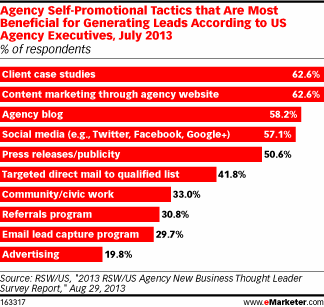
We all know that content is an integral part of any business’ marketing campaign. And one kind of content that has been proven effective in converting leads is case studies.
What is a case study? A case study is essentially a story that combines testimony, review, data, and evidence and provides account of the effectivity, efficiency, and quality of your product/service and how it has added value to the life or business of a customer.
And just how effective are case studies? Studies suggest that client case studies are the most popular self-promotional content marketing tactic used by US marketing agency executives. An eMarketer survey showed that 62.6% of respondents say that they’re effective in generating leads. It's also considered as the third most influential content marketing type in the purchase process for both small businesses and large enterprises, according to the Eccolo Media 2014 B2B Technology Content Survey Report.


(source)
Why are case studies so effective? Probably the biggest appeal of case studies is that it’s a narrative. As opposed to the usual testimony or review, the case study shows the who, what, where, when, why, and how. It tells you exactly the problem, concern, or pain point the customer had in the first place; what he purchased to address this; and how he benefitted from the product or service.
Potential customers reading the case study and find the story relevant to their own circumstances will relate to it and think, “This could be me.” And they would want to replicate that success.
And people are naturally drawn to stories. In fact, listeners remember stories up to 22 times more often than facts and figures alone. The listener's mind "synchs up" with the storyteller's mind in a process called neural coupling.
Case studies are also great points for discussion. What better way to explain your product’s features than sharing concrete examples of how it was used to address a specific pain point?
Simply put, case studies are great examples of social proof, which helps build trust and confidence in your brand.
Creating a Case Study
So how do you write a case study? We would suggest that you write it like a story.
A story has these basic elements:
- Characters – The who of the story
- Setting – The where and when of the story
- Plot – This pertains to the events that happen, and is essentially the actual story. It has a beginning, middle, and end. It is also the what of the story
- Conflict – This is the problem, challenge, or issue—or the why of the story
- Resolution – This is the solution to the conflict—or the how of the story
- Theme – The message of the story, or the lesson or insight that can be derived from it

Following these elements, you can structure and write your case study this way:
- Introduction: Establish the characters and setting of the story. Provide background information on the client, his business, size of his company, industry, his target market, and his competitive market.
- The Case: What is the conflict, the client’s pain point? Why did client reach out to you in the first place? Or what prompted him to purchase? It may also not necessarily be a problem, but a goal or challenge that needed to be accomplished.
- Solution: What was the resolution? What was done, or to be more specific: What did your product/service do to accomplish the goal, or solve the problem? Be very specific: the more details you provide, the more you demonstrate your expertise and/or authority. Provide data and facts. You may also want to mention why client chose you over other providers.
- Outcome: This is the theme of the story. And the message you want to communicate is the answer to this question: “What value did my product/service give to the client?” Describe the positive changes that took place since the implementation of your product and service, including the long-term benefits and results from the investment the client made. And again, provide data and facts.
Here’s a quick question: Are you the hero of the story? Essentially, yes, but you don’t want to be the focus of the story. The focus should be on the outcome: what was achieved for the client. Making you the hero is a real hard-sell, and might be off-putting for some people.
Do not exaggerate either. Just stick to the facts. And don't make your case studies too long. Make it a comprehensive yet easy read.
How to Promote Your Case Study
Case studies are effective so why not capitalize on them and maximize their exposure? Here are the ways to promote them:
- Website: Your case studies should be on your website, with a dedicated page for it. Make sure a website visitor will see the page immediately. It’s an instant magnet for visitors who really just want to see what you’ve accomplished—and the case studies provide proof of this.
- Social Media: Share your case studies in your social media accounts. You can even advertise it, if budget allows.
- Email Marketing: Share links to these case studies when you send out your email campaigns. Just make sure you're sharing a study that's relevant to the prospect you're writing to. You can even include the links in your email signature.
- Online Advertising: Place ads online, with the ads linking directly to the case studies' landing page.
Case studies are great social proof, no doubt about it. But be thoughtful in crafting them, and make them equally engaging and informative to yield the best results.
Photos from Pexels. Main photo by Startup Stock Photos





